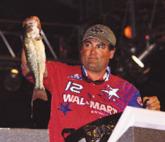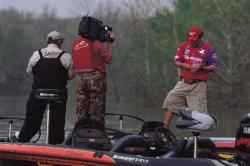Jig, worm or tube?

Can’t decide? Two pros tell you how
Dig through the tackle box of any professional bass angler on the Wal-Mart FLW Tour, and you’ll find a massive assortment of soft and hard baits. Three lures you’ll find in the boat of every top angler, however, are worms, jigs and tubes. Few would debate the merits of each one. All three are great lures, and each has accounted for some impressive stringers of bass.
One thing that isn’t so clear to many bass anglers, however, is that each of these three baits has a defined use, a specialized purpose for various seasons and situations. While all three can indeed work on any given day on just about every body of water, there are subtle nuances that set them apart from one another. What you should use, according to Camdenton, Mo., pro Denny Brauer, depends entirely on the situation.
“You have to consider the season, the fish, the water itself and the forage that the fish are actually feeding on,” Brauer said. “One bait can definitely catch more fish than the other at times.”
Whether or not a bass actually thinks “crawfish” when it sees a jig or a tube inching along the bottom or falling among a tangle of tree limbs, there’s no debate that both baits are two of the most effective lures available to anglers. As for worms, well, there’s no telling what they look like through the eyes of a bass. A leech, maybe? The bottom line is, like tubes and jigs, they catch bass when no other lure can.
Seasonal situations
Both Brauer and pro Mark Pack of Mineola, Texas, agree that each lure has a prime season. Jigs, for instance, tend to work best during the colder months, and both pros will reach for these baits in the late winter, early spring and again in the late fall after the water cools. Brauer said that there is nothing wrong with throwing a worm in the early spring, but there seems to be something about the action of a jig that attracts more bass than the sudden jerky movement of a 7-inch plastic worm. Also, the bass may be focused more on crawfish that time of year, and a jig simply does a better imitation of a crawfish.
 “I’ll stick with a jig during the warmer months if I’m fishing a lake that is known for having big bass,” Pack said. “Toledo Bend, Sam Rayburn and places like that are known for giving up heavy limits, and for some reason, jigs tend to catch larger bass than worms. You’ll get fewer bites, but they are likely going to be bigger fish.”
“I’ll stick with a jig during the warmer months if I’m fishing a lake that is known for having big bass,” Pack said. “Toledo Bend, Sam Rayburn and places like that are known for giving up heavy limits, and for some reason, jigs tend to catch larger bass than worms. You’ll get fewer bites, but they are likely going to be bigger fish.”
On the other hand, waters that don’t have high populations of largemouths to begin with are prime places to throw a plastic worm. Those slender soft plastics tend to draw more strikes than jigs or tubes, and they can help pros such as Brauer and Pack put a quick limit in the boat. In some cases, they can help produce five-bass limits when catching that many bass of any size is difficult no matter how well the fish are biting. Still, worms are best for warmer water in most situations, Brauer said, and although he finds himself fishing worms less and less these days, he still breaks out 10- and 11-inch worms when he’s targeting larger bass in deep brush piles in the summer. Pack tends to favor a plastic worm when the fish are shallow in the fall. He also fishes them around grass that isn’t too thick to penetrate, especially in late spring.
What about tubes? Both Brauer and Pack automatically reach for them during the spawn and postspawn periods. It’s no secret that tubes are killer baits when sight-fishing for bedded bass, and they’ll catch huge spawning females while a jig or worm won’t draw so much as a curious glance. Pack also likes tubes around rocks, stumps and docks. Few baits can be skipped farther under a low-slung dock than a soft plastic tube. Unlike many pros, he prefers the profile and action of a tube when he wants to catch a fast five-bass limit or when he’s fishing tough waters that don’t surrender many fish at all.
“I like tubes when I’m flipping shallow cover and I want that quick limit,” Pack said. “However, if I’m looking for a fast bite and I’m casting to shallower flats in the back of creeks, I’m going to use a worm. I can cover much more water doing that. To me, tubes and jigs are close-quarters baits for flipping. Worms are best for casting and covering water.”
Sometimes you never know
When Brauer practiced for a tournament on North Carolina’s High Rock Lake, he caught good numbers of quality fish on a jig from shallow wood cover. Naturally, he expected the same when he went back for the official practice day. The bass, however, didn’t want that same offering.
“I fished a dozen of the best logs in that area and didn’t get a single bite on the same jig that worked so well earlier,” he said. “I tried a Strike King tube and immediately had a bite, so I went right back through the same area I just fished, and I had several other bites.”
 Brauer shook those fish off during the practice period, but he stuck plenty of huge bass during the course of the tournament itself and went on to win that event. Along with earning a substantial paycheck, it taught him a valuable lesson.
Brauer shook those fish off during the practice period, but he stuck plenty of huge bass during the course of the tournament itself and went on to win that event. Along with earning a substantial paycheck, it taught him a valuable lesson.
“I’ve always kept an open mind when it comes to fishing any lure, but that tournament reinforced the fact that you simply never know if a particular lure will work unless you try it,” he said. “I think the bass were keyed in on shad during the tournament but they were looking for crayfish earlier in practice, so the spiraling fall of the tube triggered strikes where the straight fall of the jig didn’t.
“I’ll follow the basic rules regarding seasons and cover, but if the best bait for the situation doesn’t catch fish, then I won’t hesitate to try another lure,” Brauer said. “Let the fish tell you what they want, and if a jig doesn’t work when you think it should, try a worm or a tube. You might be surprised.”
Cover considerations
 A tube and a jig both work very well around fallen trees, and plastic worms can slither through a tangle of branches and entice finicky bass like no other lure. When it comes to matted grass and other dense surface cover, though, it’s important to consider each bait and how well it comes through that cover. For instance, Pack will use his own jig, made with a tungsten head to penetrate thick grass. The relatively small, heavy lure can punch through dense vegetation and reach the bottom. Tubes, on the other hand, can collect a ball of salad on every cast thanks to their bulky profiles and rounded noses.
A tube and a jig both work very well around fallen trees, and plastic worms can slither through a tangle of branches and entice finicky bass like no other lure. When it comes to matted grass and other dense surface cover, though, it’s important to consider each bait and how well it comes through that cover. For instance, Pack will use his own jig, made with a tungsten head to penetrate thick grass. The relatively small, heavy lure can punch through dense vegetation and reach the bottom. Tubes, on the other hand, can collect a ball of salad on every cast thanks to their bulky profiles and rounded noses.
Brauer also likes to use a heavy jig to bust through heavy cover like matted grass. “It may not necessarily be the best bait for the season, but if it presents itself better than a worm or tube in that situation, then it’s the best choice,” he said.
Murky water demands special consideration as well. Although bass rely primarily on their eyes to locate and catch food, they adapt to muddy water and detect food through vibrations detected by their lateral lines. Therefore, according to Pack and Brauer, it’s critical to use a bait that moves the most water and gives off the most vibration. Their choice? A jig, of course, particularly a jig that has a set of rattles attached to it.
None of the above?
Sometimes, Pack and Brauer will skip right past a jig or a worm or a tube and go straight for something like a creature bait. Brauer said that in lakes that have extremely high fishing pressure, bass can become lure-shy and avoid those three baits altogether. Creature baits, such as Strike King’s Wild Thing or Lake Fork Trophy Tackle’s Lake Fork Creature, are also excellent choices for muddy water.
“Creature baits tend to move more water than a tube or a worm, so they are good choices when the visibility is low,” Pack said.